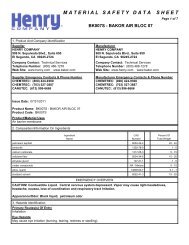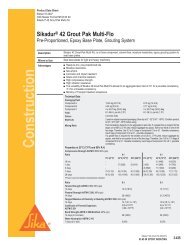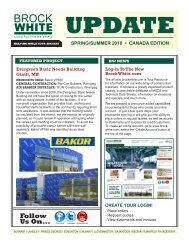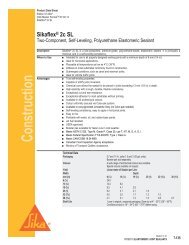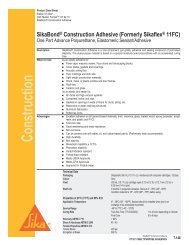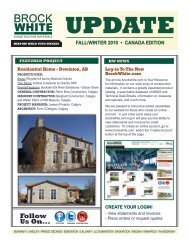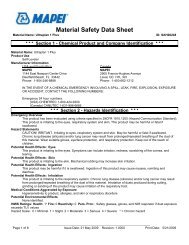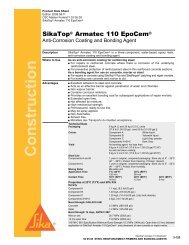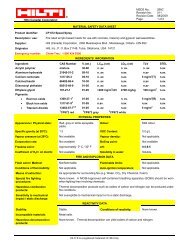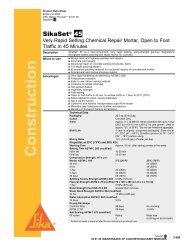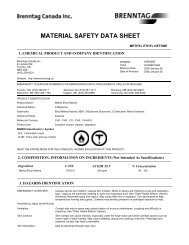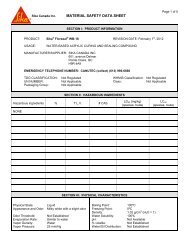Operations Manual - WSR18A - Home Depot
Operations Manual - WSR18A - Home Depot
Operations Manual - WSR18A - Home Depot
You also want an ePaper? Increase the reach of your titles
YUMPU automatically turns print PDFs into web optimized ePapers that Google loves.
en<br />
power tool’s operation. If damaged, have the<br />
power tool repaired before use. Many accidents<br />
are caused by poorly maintained power tools.<br />
f) Keep cutting tools sharp and clean. Properly<br />
maintained cutting tools with sharp cutting edges<br />
are less likely to bind and are easier to control.<br />
g) Use the power tool, accessories and tool bits<br />
etc. in accordance with these instructions taking<br />
into account the working conditions and the<br />
work to be performed. Use of the power tool for<br />
operations different from those intended could<br />
result in a hazardous situation.<br />
6.1.5 Battery tool use and care<br />
a) Recharge only with the charger specified by the<br />
manufacturer. A charger that is suitable for one<br />
type of battery pack may create a risk of fire when<br />
used with another battery pack.<br />
b) Use power tools only with specifically designated<br />
battery packs. Use of any other battery<br />
packs may create a risk of injury and fire.<br />
c) When battery pack is not in use, keep it away<br />
from other metal objects, like paper clips,<br />
coins, keys, nails, screws or other small metal<br />
objects, that can make a connection from one<br />
terminal to another. Shorting the battery terminals<br />
together may cause burns or a fire.<br />
d) Under abusive conditions, liquid may be ejected<br />
from the battery, avoid contact. If contact accidentally<br />
occurs, flush with water. If liquid<br />
contacts eyes, additionally seek medical help.<br />
Liquid ejected from the battery may cause irritation<br />
or burns.<br />
6.1.6 Service<br />
a) Have your power tool serviced by a qualified<br />
repair person using only identical replacement<br />
parts. This will ensure that the safety of the power<br />
tool is maintained.<br />
6.2 Additional safety instructions<br />
6.2.1 Personal safety<br />
a) Wear ear protectors. Exposure to noise can cause<br />
hearing loss.<br />
b) Hold power tools by insulated gripping surfaces,<br />
when performing an operation where the cutting<br />
accessory may contact hidden wiring or its own<br />
cord. Cutting accessory contacting a “live” wire<br />
may make exposed metal parts of the power tool<br />
“live” and shock the operator.<br />
c) Always hold the power tool securely with both<br />
hands on the grips provided. Keep the grips dry,<br />
clean and free from oil and grease.<br />
d) Breathing protection must be worn if the power<br />
tool is used without a dust removal system for<br />
work that creates dust.<br />
e) Improve the blood circulation in your fingers by<br />
relaxing your hands and exercising your fingers<br />
during breaks between working.<br />
f) Operate the power tool only as intended and<br />
when it is in faultless condition.<br />
g) Wear protective gloves when changing insert<br />
tools as the insert tools get hot during use.<br />
h) Switch the power tool on only after bringing it<br />
into the working position.<br />
i) Engage the safety lock before storing or transporting<br />
the tool.<br />
j) Avoid unintentional starting. Never carry the<br />
power tool with your finger on the control switch.<br />
Remove the battery from the power tool during<br />
work breaks, before carrying out maintenance,<br />
before changing cutting tools and before transporting<br />
the power tool.<br />
k) Children must be instructed not to play with the<br />
power tool.<br />
l) The power tool is not intended for use by children,<br />
by debilitated persons or those who have<br />
received no instruction or training.<br />
m) WARNING: Some dust created by grinding,<br />
sanding, cutting and drilling contains chemicals<br />
known to cause cancer, birth defects,<br />
infertility or other reproductive harm; or serious<br />
and permanent respiratory or other injury.<br />
Some examples of these chemicals are: lead from<br />
lead-based paints, crystalline silica from bricks,<br />
concrete and other masonry products and natural<br />
stone, arsenic and chromium from chemicallytreated<br />
lumber. Your risk from these exposures<br />
varies, depending on how often you do this type<br />
of work. To reduce exposure to these chemicals,<br />
the operator and bystanders should work in a<br />
well-ventilated area, work with approved safety<br />
equipment, such as respiratory protection appropriate<br />
for the type of dust generated, and<br />
designed to filter out microscopic particles and<br />
direct dust away from the face and body. Avoid<br />
prolonged contact with dust. Wear protective<br />
clothing and wash exposed areas with soap and<br />
water. Allowing dust to get into your mouth,<br />
6



